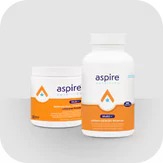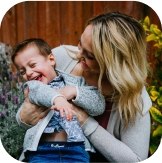For the 1 in 36 children diagnosed with Autism Spectrum Disorder (ASD) (1) and the 1 in 6 children with developmental disabilities (2), the transition back to school after summer break can be particularly challenging. The shift from relaxed summer routines to the structured classroom environment can trigger anxiety, behavioral issues, and emotional dysregulation.
As a parent of a child with ASD, watching your child struggle with this transition can be heartbreaking. However, with careful planning, targeted support, and patience, you can help your child navigate this challenging time and set them up for a successful school year.
At Aspire Nutrition, we understand the unique challenges families affected by ASD face. In this article, we'll share our best tips and actionable steps to support your child through the back-to-school transition, from establishing predictable routines to prioritizing nutrition and self-care. Together, we can empower our children to embrace the new school year with confidence and resilience.
Preparing for a Successful Transition
One of the most effective ways to help your child with ASD navigate the back-to-school transition is to start preparing well in advance. Just remember, the goal of preparation is not to eliminate all challenges but rather to equip your child with the tools and skills they need to navigate them. By taking a proactive approach and breaking down the transition into manageable steps, you can help your child feel more confident and prepared for the new school year.
Here are some steps you can take to get your preparation for a successful back-to-school transition off to a great start. Pick a new one this school year that you haven’t tried before and see how it might help you this year.
- Focus on the Positive - Begin by discussing the new school year with your child, focusing on the positive aspects such as seeing old friends, making new ones, and learning interesting things.
- Arrange a Visit - If possible, arrange a visit to the school before the first day, allowing your child to explore their new classroom, meet their teacher, and familiarize themselves with the layout of the building. This can help alleviate some of the uncertainty and fear of the unknown.
- Practice School Routines at Home - At home, start practicing school routines a few weeks before the first day. This may include waking up at the same time each morning, getting dressed, eating breakfast, and packing a backpack. By gradually introducing the idea of the upcoming changes and helping them practice new routines, you can reduce anxiety and build familiarity.
- Visual Schedules - Consider creating a visual schedule that outlines the daily routine using pictures or symbols, as this can help your child understand and follow the sequence of events.
- Social Stories - Social stories are another powerful tool for preparing your child for the transition. These short, simple stories describe a specific situation, skill, or concept in a way that is easy for children with ASD to understand. You can create a social story about the first day of school, highlighting what to expect, how to respond to certain situations, and coping strategies to use if feeling overwhelmed.
- Collaborate with Your School - It's also crucial to collaborate with your child's school to ensure that necessary accommodations and support services are in place. This may include sensory supports, modified assignments, or additional staff support. By working together with the school team, you can create a comprehensive plan that sets your child up for success.
Establishing Predictable Routines
For children with ASD, predictable routines are essential for providing a sense of structure, security, and control in an often unpredictable world. When routines are consistent and familiar, children are better able to regulate their emotions, engage in learning, and navigate social interactions.
I know we all know this, but if you’re anything like me, a good refresher is always helpful during these transitional times. Here are a few things to keep in mind surrounding routines.
- Morning and Evening Routines - One of the most important routines to establish is a consistent morning and evening schedule. Start by breaking down each routine into small, manageable steps. For example, a morning routine might include waking up, brushing teeth, getting dressed, eating breakfast, and packing a backpack. Use visual aids like timers, checklists, or pictures to help your child understand and follow the sequence of steps.
- Leave Margin - Build in extra time for each step, in other words: leave margin! Children with ASD may need more time to process instructions and complete tasks. Consider incorporating rewards or incentives for completing each step or the entire routine, as this can help motivate and reinforce positive behaviors.
- Balance Structure and Flexibility - When creating routines, it's important to strike a balance between structure and flexibility. While predictability is key, it's also essential to teach your child how to cope with minor changes or disruptions to their routine. This might involve practicing problem-solving skills, using calming strategies, or seeking help when needed.
By establishing predictable routines at home and school, you can help your child feel more secure, confident, and in control. Over time, these routines will become second nature, providing a solid foundation for learning, growth, and success.
Partnering With Your Child's School
Navigating the back-to-school transition is not a journey you have to undertake alone. Building a strong partnership with your child's school team is essential for ensuring that your child receives the support and accommodations they need to thrive.
- Connect Before It Begins - Before the school year begins, reach out to your child's teacher or school administrators. Share your child's strengths, challenges, sensory needs, communication style, learning preferences, and successful strategies you've used at home. This information will help the school team better understand your child and develop an appropriate support plan.
- Communication Plan - Establish a system for regular communication with your child's teacher, such as weekly email updates or monthly phone check-ins, to discuss progress, address concerns, and make adjustments to the support plan as needed. Be open to feedback and suggestions from the school team, as they can provide valuable insights and expertise.
- Education Plans - Review your child's Individualized Education Plan (IEP) (3) or accommodations under section 504 carefully to ensure it includes all necessary accommodations and supports. Advocate for your child's needs if something is missing or inadequate. Document conversations or agreements in writing and follow up regularly to ensure the plan is being implemented effectively.
- Stay Collaborative and Solutions-Focused - Throughout the school year, maintain a collaborative and solution-focused approach when working with your child's school team. Recognize the school's limitations and constraints while advocating for your child's needs. Work together to find creative solutions and compromises that prioritize your child's well-being and success.
Remember, a strong parent-school partnership is built on a foundation of mutual respect, trust, and open communication. By working together as a team, you can create a supportive and inclusive educational environment that allows your child to reach their full potential.
The Role of Nutrition
While creating predictable routines and fostering a strong parent-school partnership are crucial for a successful back-to-school transition, it's also important to consider the role of nutrition in supporting your child's overall well-being. Research has shown that many children with ASD experience gastrointestinal issues, toxin overload, inflammation, and nutrient deficiencies, which can exacerbate symptoms and impact their ability to cope with changes and stress (4)(5)(6)(7).
By prioritizing a nutrient-dense, whole-foods diet and incorporating targeted supplements, you can help support your child's gut health, immune function, and brain development. Proper nutrition can lead to improvements in focus, behavior, and emotional regulation(8)(9), which are all essential for navigating the challenges of the back-to-school transition.
At Aspire Nutrition, we understand the unique nutritional needs of children with ASD. That's why we've developed our Core 4 Protocol, which includes four key supplements designed to support optimal health and development:
- Bio-Heal: Supports healthy gut, brain, and immune system function*
- Multi+: Supports nutrition, focus, and brain function*
- Bio-Clear: Aids in detoxification and supports speech*
- Beyond Omega: Promotes healthy inflammation response and brain function*

When used together, these supplements provide a comprehensive approach to supporting your child's physical and mental well-being during times of transition and beyond.
For a limited time, we're offering a special back-to-school promotion on our Core 4 Protocol bundle. From now until August 24, 2024, you can save $20 on your purchase of the bundle, making it even easier to provide your child with the nutritional support they need to thrive.
To take advantage of this offer and learn more about how Aspire Nutrition can support your family's journey, learn more about our Core 4 Protocol. Remember, small changes in nutrition can make a big difference in your child's ability to navigate challenges and reach their full potential.
Real Families. Real Results.
The following stories come from real families who have witnessed the remarkable difference the Core 4 Protocol has made in their children's lives. These transformations inspire us every day, and we hope they encourage you to explore how nutrition can help support your family's unique journey towards thriving:
"I'm glad I went ahead followed that gentle nudge or else I wouldn't be happy to share my experience regarding the positive change in my daughter's behaviour in school. I started giving this to my daughter Nov. 4th 2019, she still had meltdowns, defiant to adults & had a potty accident while in the school playground. Four days later, her case manager happily reported she did wonderful the whole day! Her teacher notes about her: 1.) much happier, more focused and following teacher's instructions, 2.) transitions in-class have been much easier (before would cause huge meltdowns, lay down the floor and scream or her sit in the corner and cry), 3.) getting better in initiating and maintaining longer two-way conversations (we are multilingual at home, before she only answered ""yeah"" to a why/who question), 4.) working to communicate clearly her toilet needs to her teacher, 5.) having fun with kids her age in the playground and is getting better remembering her friends' names. She still needs support in some areas but definitely happy to see progress overall. It's almost end of month and I received consistent good notes from her teacher. We don't do GFCF diet but include fermented food & bone broth for years, Bio-Heal is the only recent addition. I mix this powder with yogurt dinnertime. The first few days she went 3 times but now is back to once a day. Before she'd wake at midnight crying & have a hard time getting back to sleep. She now wakes up happy in the morning. She shares her happy or sad feelings, and explains to me why. We used a different probiotic before but Bio-Heal has made a huge difference in her behaviour! I've already read about the gut-brain connection & I believe this product has the right combination for healing and a big plus that it is an ""all-in-one"" powder, truly perfect for my family of 5 with a busy schedule! Thank you so much for helping this mama! Every dollar is definitely worth the ""She did great today"" notes! "
"I want to start by saying thank you to Aspire Nutrition for offering such great products for the entire family. We started using Bio-Heal powder for our daughter just over 2 years ago. She has been constipated since birth and once we started Bio-Heal she was finally able to poop without her face turning purple and her body hurting from trying to push it out. She has sensory processing disorder and ADD. Her teacher called us in the spring to let us know her concentration was off. So after talking to the customer support at Aspire Nutrition, we decided to add Multi+ and Beyond Omega to her routine to see if the teacher noticed a difference. We asked for a follow up call a month after starting all 3 together and the teacher told us to keep doing what we were doing because she was finishing her work in school and seemed much more focused. We of course with her sensitivities to taste have to mix up how we serve it to her but it eventually is taken everyday even sometimes with a little pushback. She knows she needs to take it to make school a little easier for her. We love your line and myself and my daughter are both taking just about all of your products combined most recently adding in your new immunity product! Thank you again for such amazing products and support! "
"I was so hesitant to buy this because I have tried so many different probiotics for my son and haven't noticed a difference. This actually made a difference!! My son is 8 and has high functioning autism, adhd, ocd, and tics. He also has other gut issues (prolapse rectum, constipation). Within a week of taking this, his speech improved and his focus in school! His anxiety and ocd seem to be at bay for the time being and haven't noticed as many tics. He also told me it is so fast to go poop now! For the first time in a LONG time I feel so hopeful. The brain- gut connection must be legit because he is literally being healed. His teachers have noticed a big difference. I also started my son on CALM (magnesium supplement), Omega3s, and broccoli sprouts.. try it all if your kiddo sounds like mine. Seriously, I am crying tears of joy and thanking God for answering my prayers. Having a child who struggles is the hardest thing in life, I empathize with all you other parents out there!! Don't give up, there is stuff out there to help your kid- I think this is one of them!!"
Prioritizing Self-Care for Parents and Caregivers
As a parent or caregiver of a child with ASD, it's easy to neglect your own well-being while focusing on your child's needs. Prioritizing your self-care is essential for maintaining the strength, resilience, and positive mindset needed to effectively support your child.
I want to encourage you to set aside time for activities that bring you joy, relaxation, or a sense of accomplishment. Reach out for help and support when needed, and consider joining a local support group or online community. If possible, arrange for respite care or share caregiving responsibilities with trusted individuals to allow for much-needed breaks.
By taking care of yourself, you are better equipped to provide the love, support, and guidance your child needs to thrive. It’s important, you are important, and you are an unbelievable parent. Remember that!
Go Reach that Extraordinary Potential
At Aspire Nutrition, we believe in the extraordinary potential of every child with ASD. As you navigate the challenges and triumphs of the back-to-school transition, know that you are not alone. Our team is here to support you with high-quality supplements, informative resources, and a compassionate community that understands your journey.
With love, perseverance, and the right support, your child can achieve more than you ever thought possible. Embrace the journey ahead, celebrate the small victories, and trust in your child's ability to grow and thrive.
Sources
- Centers for Disease Control and Prevention. (2023, March 23). Autism Prevalence Higher, According to Data from 11 ADDM Communities. Retrieved from https://www.cdc.gov/media/releases/2023/p0323-autism.html
- American Speech-Language-Hearing Association. (2019, December 1). Autism Rates Increasing, CDC Says. The ASHA Leader, 24(12), 12. https://doi.org/10.1044/leader.NIB1.24122019.12
- Sparks, S. D. (2023, July 11). What Is an IEP? Individualized Education Programs, Explained. Retrieved from https://www.edweek.org/teaching-learning/what-is-an-iep-individualized-education-programs-explained/2023/07
- Sanctuary, M. R., Kain, J. N., Chen, S. Y., Kalman, D., Maenner, M. J., Alam, S., & Beasley, J. B. (2019). Rates of Autism Spectrum Disorder Diagnosis by Age 8 Years From 2010 to 2018 Based on Adverse Childhood Experiences. American Journal of Preventive Medicine, 57(5), 693–700. https://doi.org/10.1016/j.amepre.2019.06.008
- Obodzinskaya, I. S., Pavlov, K. S., Portnova, G. V., & Yurov, I. Y. (2023). Neuro-inflammatory process as a key etiopathogenetic factor in the development of autism spectrum disorder in pediatric patients. PSYCHIATRY, 21(5), 47–55. https://doi.org/10.30629/2618-6667-2023-21-5-47-55
- Rocco, C. D., & Pico, C. (2023). Upregulation of Inflammatory Mediators in Peripheral Blood CD40+ Cells in Children with Autism Spectrum Disorder. International Journal of Molecular Sciences, 24(8), 7475. https://doi.org/10.3390/ijms24087475
- Hafsi, M., Canals, R., Gassab, L., Mabrouk, B., Limam, F., & Makhlouf, J. (2023). Nutritional Status and Feeding Behavior of Children with Autism Spectrum Disorder in the Middle East and North Africa Region: A Systematic Review. Nutrients, 15(3), 711. https://doi.org/10.3390/nu15030711
- Al-Beltagi, M. (2021). Autism medical comorbidities. World Journal of Clinical Pediatrics, 10(3), 15–28. https://doi.org/10.5409/wjcp.v10.i3.15
- Sullivan, J. C., Miller, L. J., Nielsen, D. M., & Schoen, S. A. (2014). The Presence of Migraines and Its Association With Sensory Hyperreactivity and Anxiety Symptomatology in Children With Autism Spectrum Disorder. Autism, 18(6), 743–747. https://doi.org/10.1177/1362361313489377
- Doreswamy, S., Bashir, A., Guarecuco, J. E., Lahori, S., Baig, A., Narra, L. R., Patel, P., & Heindl, S. E. (2020). Effects of Diet, Nutrition, and Exercise in Children With Autism and Autism Spectrum Disorder: A Literature Review. Cureus, 12(12), e12222. https://www.ncbi.nlm.nih.gov/pmc/articles/PMC7815266
- Reynolds, A., Krebs, N. F., Stewart, P. A., Austin, H., Johnson, S. L., Withrow, N., Molloy, C., James, S. J., Johnson, C., Clemons, T., Schmidt, B., & Hyman, S. L. (2012). Nutrient Intake From Food in Children With Autism. Pediatrics, 130(Supplement_2), S145–S153. https://www.ncbi.nlm.nih.gov/pmc/articles/PMC4536585

















